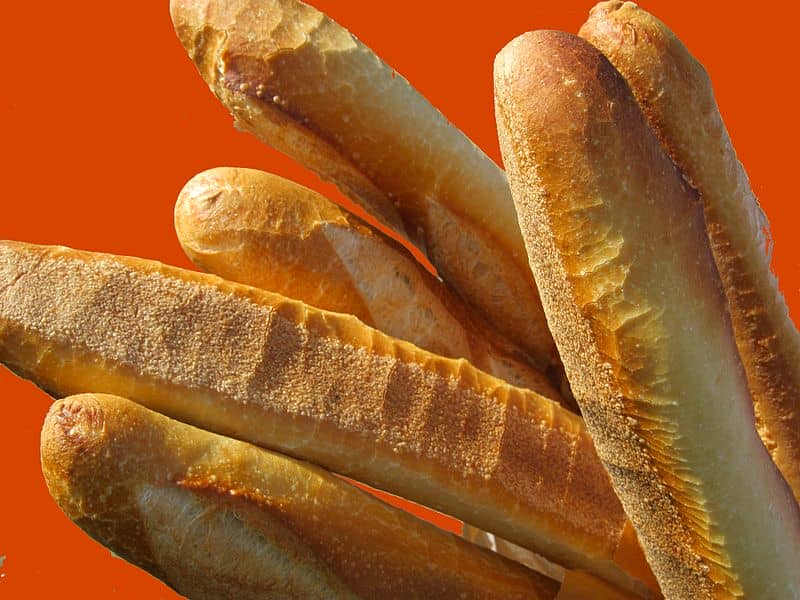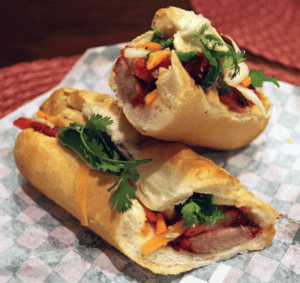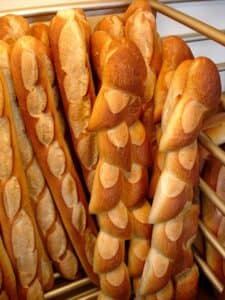Do you want to learn interesting facts about baguettes?
A baguette is a long, thin French loaf, commonly made using basic lean dough. This bread, a French staple food, is recognizable by its length and crisp crust. It can be served as an appetizer or part of the main course.
It became extremely popular in France in the 1700s and up to this day, it is often considered the national bread of France. During the first World War, the workforce shortage in French bakeries prompted bakers to find a more efficient way of baking.
Baguette – alongside wine, cheese, and the beret – is practically synonymous with French people and France. It’s one of the traditional foods in France and it’s pretty common to find this bread in apero gatherings. It’s sort of a national symbol for the French and they take huge pride in it. Outside France, the baguette is commonly considered a symbol of French culture.
Much of this bread’s history is speculation, but some facts about the baguette can be established. Baguette has become so rooted in French culture that it is deemed rude if a host entertaining guests at dinner does not have a fresh baguette as a side dish.
Things you'll find in this article
- 18 Facts About Baguettes – The National Bread Of France
- 1. Baguette means stick, wand, or baton
- 2. Baguette is an Austrian invention, not French
- 3. Baguette is first recorded as a kind of bread in 1920
- 4. There’s a yearly competition for baguette making
- 5. Not all long loaves are baguettes
- 6. Baguettes dry up faster than most types of bread
- 7. There are two types of baguette
- 8. Baguette is also a staple food in Vietnam
- 9. There’s a law on how to make this bread
- 10. There are different names for baguettes depending on the size
- 11. There’s also an Italian baguette
- 12. Baguette is a versatile bread
- 13. Baguette was developed to be a fast-baking solution to a law in 1920
- 14. The French eat 320 baguettes every second
- 15. The shape of a baguette is significant to producing its thick crust
- 16. Baguettes are steam-cooked to get that light, fluffy interior
- 17. At least 10 billion baguettes are baked in France yearly
- 18. You may buy just a half of the baguette
18 Facts About Baguettes – The National Bread Of France

If you’d like to learn more about France national bread, here are 18 Baguette facts worth knowing.
1. Baguette means stick, wand, or baton
The word “baguette,” coined in the early 18th century, means “stick,” “wand,” or ” baton.” It was derived from Italian bacchetto, diminutive of bacchio, which came from Latin baculum that translates to “staff.”
Alternative names for baguette are French stick, French loaf, and French bread.
2. Baguette is an Austrian invention, not French
One of the most interesting facts about baguette is that it is said to have been imported to France from Vienna. Its invention is credited to an Austrian baker called August Zang, who introduced Viennese steam oven baking to Paris in 1839. He also introduced the croissant and pain viennois (Vienna bread), the latter being much sweeter and softer than the standard baguette.
3. Baguette is first recorded as a kind of bread in 1920
Baguette is first recorded as a kind of bread in 1920.
4. There’s a yearly competition for baguette making

In April 1944, Le Grand Prix de la Baguette was started in France. It was a competition to determine who made the best baguettes. Since then nearly 200 bakers compete yearly, following strict guidelines in front of a 14-judge panel. Their baguettes are judged based on baking, appearance, smell, taste, and crumb. The contest winner receives 4000€ and gets to supply daily bread to the French president for a whole year until a new winner is proclaimed.
5. Not all long loaves are baguettes
Not all long loaves are baguettes. The rugby ball-shaped loaf is a bâtard, literally meaning “bastard.” It’s called a “torpedo loaf” in English. Flûte, another tubular-shaped loaf that’s about twice the baguette’s size, is known as a “Parisienne” in the USA.
6. Baguettes dry up faster than most types of bread
Baguettes are rock-hard the next day as they go stale when they lose their moisture. Because they are almost fat-free, baguettes dry up much faster than bread that contains oil or butter which allows for moisture to stay trapped in longer.
7. There are two types of baguette
The standard baguettes are called baguettes ordinaires. They are baked with baker’s yeast. The artisan-style loaves, on the other hand, are often made with pre-fermented flour which increases flavor complexity and other characteristics and may include whole-wheat flour or rye and other grains.
8. Baguette is also a staple food in Vietnam

There is also a Vietnamese variation of baguette. It’s called bánh mì, which literally means “bread” in Vietnamese. Bánh mì refers to a type of short baguette. Plain bánh mì is also eaten as a staple food.
9. There’s a law on how to make this bread
In 1993, the French government passed a law called the Décret Pain, or the French bread law. This law states that traditional baguettes have to be made with just four ingredients: wheat flour, water, salt, and yeast. They should also be strictly made on the premises where they’re sold. It is one of the most interesting facts about food in France that you would think is just made up.
10. There are different names for baguettes depending on the size
A thinner loaf is called a ficelle, after the French word meaning “string.” There’s also that short baguette that is sometimes called a baton. Both are not officially defined, however. In major dictionaries, they are mere baguettes.
11. There’s also an Italian baguette
Other types of baguettes are made outside of France, such as Italian baguettes, or baguette italienne. This type contains more spices and a denser texture, which gives it a slightly different, more Italian, taste.
12. Baguette is a versatile bread
Baguettes can be eaten on their own or with balsamic vinegar dip or olive oil. You can pair a baguette with other ingredients to make bruschetta with tomato and basil. It can be transformed into garlic bread as well, while stale baguettes are turned into croutons. In Vietnam, they also use different kinds of meat and vegetables to match with baguettes.
13. Baguette was developed to be a fast-baking solution to a law in 1920
The baguette was the result of a 1920 law regarding the working hours of French bakers. This law banned bakers from working before 4 AM and no later than 10 PM. This made it difficult to have fresh bread in bakeries in the morning so a fast-baking new loaf was developed – the baguette.
14. The French eat 320 baguettes every second

Probably not a surprising Baguette fact is that the French eat 320 baguettes per second. That’s about half a baguette per day an average Frenchman consumes. This is less compared to a whole baguette the French ate in the 1970s and much less still compared to more than three in the 1900s. This is according to the Observatoire du Pain (Bread Observatory of France).
15. The shape of a baguette is significant to producing its thick crust
During the baking process, the shape of a baguette allows a maximum amount of dough to be exposed directly to heat. This process produces the thick crust of a baguette.
16. Baguettes are steam-cooked to get that light, fluffy interior
Before the exterior of a baguette crusts over and becomes crispy, the bread is cooked with steam in a deck oven at a temperature of at least 205°C (400°F). This enables the baguette’s interior to be light and fluffy.
17. At least 10 billion baguettes are baked in France yearly
Baguettes are eaten in many other countries the world over, but it is the French who love it so much that baguettes are made in billions annually.
18. You may buy just a half of the baguette
At stores, you can ask for a demi-baguette – just half of the bread – because the baguette’s shelf life is only one day. It goes stale the next day and stores consider this so they allow their baguettes to be sold in halves.

Hi, I’m Christine – a full-time traveler and career woman. Although I’m from the Philippines, my location independent career took me to over 40 countries and lived in 4 continents in the last 10 years, including France. A self-proclaimed Francophile, I love everything France.
